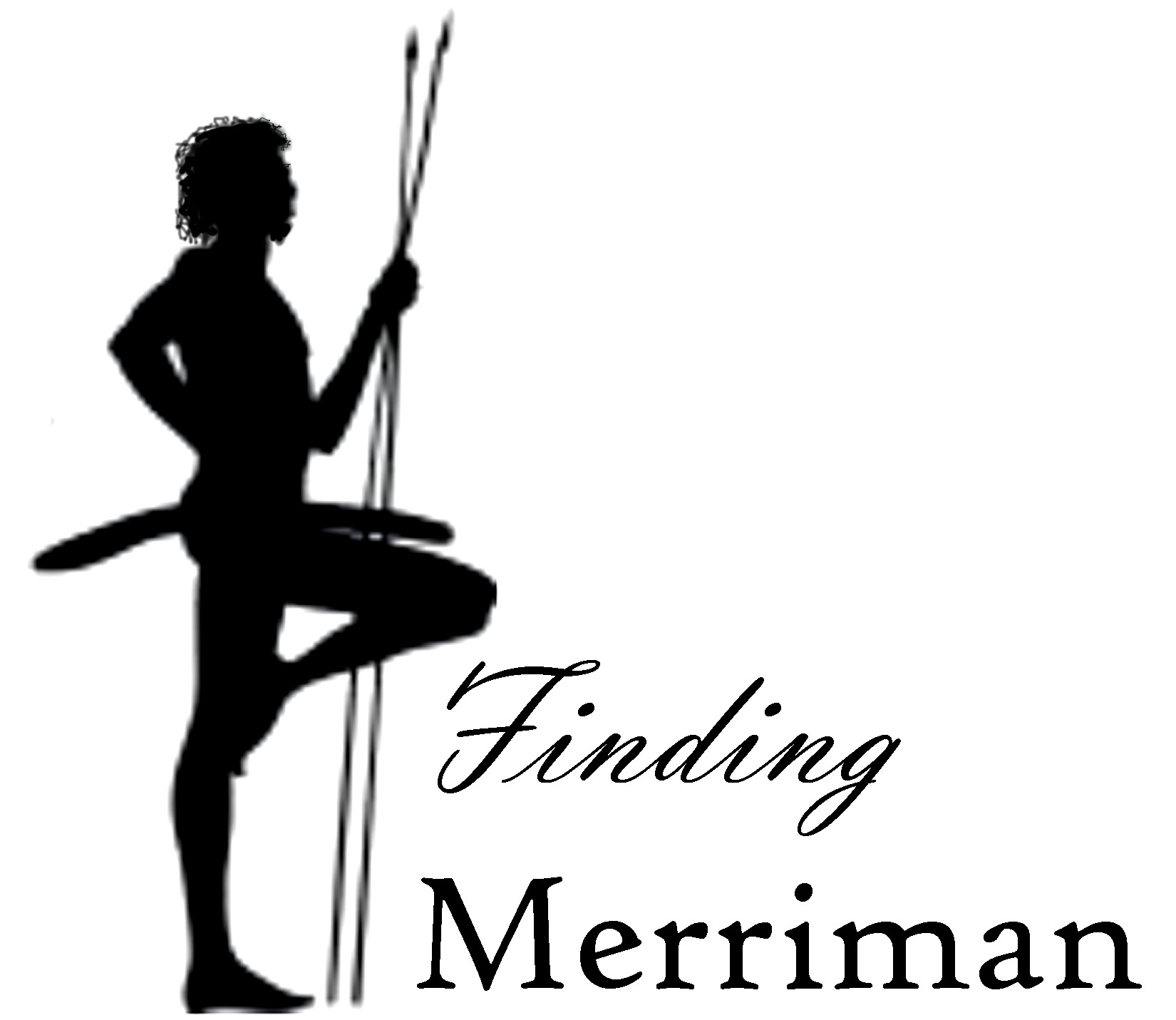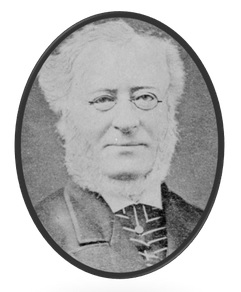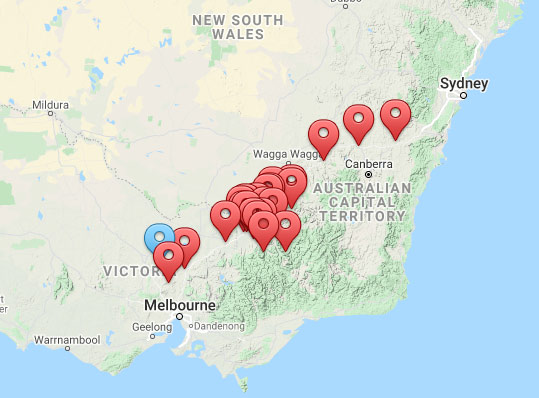Captain Charles Hutton of Campaspe Plains Station
Hutton was born in London in 1809 and joined the East India Company as a cadet in 1825. He was commissioned as an ensign in 1826, when stationed in India. In 1937, Hutton took leave and travelled to New South Wales and participated in an exploratory party looking for suitable pastoral country.
He set out with a large overlanding party including eight assigned convicts from Goulburn in January or February 1838.
Hutton and his party first settled on the upper reaches of the Wild Duck Creek, which he called Vincent Creek. They stayed here for a few months and then moved further downstream. The original head station was on the west bank of the Wild Duck Creek. The original Campaspe Plains Station was approximately 400,000 acres of grazing land, which comprised the country later taken up by the Axedale, Barnadown, Muskerry, Mt. Pleasant, Majors Line and Mitchells Creek Stations.
Hutton resigned from the East India Company in 1839, while still on leave. The establishment of his station requiring his full attention.
Due to a drought at the time, the sheep had to be spread out over a vast area to obtain enough feed. An outstation hut was established on the Campaspe, where the Barnadown bridge now stands. This was 18 miles from the main station on Wild Duck Creek. Hutton sent two flocks of sheep, two shepherds, and a hut keeper to the new outstation.
Hugh Bryan, a shepherd, and James Neill, a hut keeper, were killed in May 1839 at the Barnadown outstation by Aborigines, possibly as retribution for the earlier Aboriginal deaths.
Mounted police, accompanied by Charles Hutton, killed at least five Aboriginals, in what was later described, after an official investigation, as a deliberately planned illegal reprisal.
Edward Stone Parker, the Assistant Protector of Aborigines for the region, described the massacre as: ‘…it was a deliberately planned illegal reprisal on the aborigines, conducted on the principle, advocated by many persons in this colony, that when any offence is committed by unknown individuals, the tribe to which they belong should be made to suffer for it.’
The body of James Neill was not found in the initial search. However, in 1878, contractors digging a trench unearthed the body of a European male, one and a half miles from where the outstation was situated. Evidence, including brass buttons and a buckle and the location of the body, indicated to the authorities that it almost certainly was the body of James Neill.
Friday, January 24th 1840: GA Robinson headed from Mr. Munro’s to Capt. Hutton, a journey of one mile. He writes, “Proceeded down a small valley to the paddocks of wheat and wool sheds. A beautiful place, a valley undulating with grassy hills and open forest trees. A water hole is here. The fencing, two rail split post, contains 48 acres in two paddocks. There was a wool shed, … in a small valley in a continued line with water holes, most parts containing water, through which valley the road runs…there are on each side of the valley through which the road winds, a belt of low stoney forest hills and would afford the security to the Aboriginal natives…when leaving this forest belt, and opening out upon the plain, the change of scene was delightfully pleasant. Where Mr Hutton’s house stands is a beautiful sight, with extensive plains before it and some thousands of acres of good sheep country, mainly open forest hills, extending tens of thousands of acres on every side.“
“was cordially and hospitably received by Mr Hutton. The house contained two large rooms, plastered inside and out and plastered ceilings, and well-built doors, windows and boarded floors, good kitchen and stove and other out offices, and a good garden in which green, excellent vegetables: carrots, turnips, kole, cabbage, and peas, in abundance, beans, potatoes, and English garden flowers…Mr Hutton’s station is 90 miles from Melbourne, 10 miles
GA Robinson was invited to join Hutton for the evening meal. “The dinner was set out as well, if not better, than many houses at Melbourne – mutton and vegetables, everything clean like an English gentleman’s table.”
Robinson wrote, “Mr Hutton was a lieutenant in the company service; has made a good deal of money since his arrival.”
“Two gentlemen have bought Mr Hutton’s run and sheep (7,000*) for 10,000 pounds, so said. Gentlemen’s names are Jennings and Pase. (Daniel Jennings and George Playne*) The former was a stockbroker in London, the other was a medical man from London and brother-in-law to Jennings.” GA Robinson’s journal Jan 1840.
* Pastoral Settlement in Northern Victoria, RANDALL J.O. Axedale Antics, March 2011 https://axedalethenandnow.wordpress.com/
Aboriginal Protector for the Loddon District, Edward Stone Parker, took Mr Cosgrove’s deposition: “Cosgrove gave his evidence very reluctantly. No doubt in my mind much a greater slaughter had been made…” (is this referring to the Campaspe Plains massacre that occurred after the murders of his shepherd and hut keeper?)
During GA Robinson’s Jan 1840 visit, he wrote, “Saw a man named McLennan who was with Major Mitchell as bullock driver. He was very unintelligent and stupid; was in Hutton’s employ.”
It is worth remembering that an article published in 1875 described a search for Merriman and Harlequin, where Bill Thomas, ‘that veritable tiger’, wished to shed blood upon finding the brothers. The article reported Bill Thomas locked the brothers in George Faithful’s hut, intending to set it on fire. Bill Thomas had also been a bullock driver for the surveyor, Thomas Mitchell, who, it should be remembered, was later censured after ordering his men to shoot at Aboriginal people on the Murray River.
In April 1839, five Indigenous people were killed by three white men. In response to these deaths, Hugh Bryan, a shepherd, and James Neill, a hut keeper, were killed in May 1839 by Taungurung people, who had robbed a hut of bedding, clothes, guns and ammunition. These Indigenous people also ran a flock of 700 sheep off the property, possibly as retribution for the earlier Aboriginal deaths.
Hutton immediately put together an armed party of settlers who tracked and caught the Aboriginals with a flock of sheep 48 kilometres (30 miles) away near the Campaspe Creek. An armed confrontation between the settlers and Aboriginals occurred for up to half an hour. Hutton claimed privately that nearly 40 Aboriginal people were killed.
The following month, Hutton led a party of mounted police and came upon a party of local Dja Dja Wurrung whom Hutton had previously forced off his run, even though these people had been friendly to him since his arrival. The Aboriginal camp near the Campaspe Creek was charged by Hutton and the mounted police with no warning given, with six Dja Dja Wurrung being shot in the back and killed as they tried to flee, and others were wounded.
George Robinson described Charles Hutton and his attitude to “the Blacks” in his journal of 24 January 1840: ‘Mr H. avowed [his approach to the natives] to be terror; to keep the natives in subjection by fear, and to punish them wholesale, that is, by tribes and communities. If a member of a tribe offend, destroy the whole. He believed they must be exterminated.’
Charles Hutton sold the property in late 1839 to Jennings and Pase. The Campaspe Plains Run was subdivided into a number of smaller properties in the 1840s.
In 1840, Hutton took up a station on the Flowerdale on the King Parrot Creek. In 1841, he acquired a property on the Merri Creek. The following year, he took his young bride to the property, and several of their children were born there.
Hutton had also bought a substantial parcel of land in Crown portions 52, 53 and 68, northeast of the intersection of Smith Street and Victoria Parade. In the late 1840s, he commenced subdividing and created a new north-south axis, Wellington Street. Another landowner, the Reverend George Otter, owned land to the north in Portion 73, and continued Wellington Street northwards to suit his own subdivision. However, Hutton’s subdivision also created several shorter streets without reference to Otter’s neighbouring subdivision, creating a typical Collingwood hodgepodge of unrelated streets, some of which required Council initiatives in later years to resolve.
No official action was taken against Hutton. https://en.wikipedia.org/wiki/Campaspe_Plains_massacre
The Department of Primary Industries site – Victorian Resources Online –
http://vro.dpi.vic.gov.au/DPI/Vro/vrosite.nsf/pages/landuse_hist_geog_lscape_costerfield_european
Ian CD Clark – scars on the landscape pg 58
Newspaper article from The Argus, Thu 23 Apr 1936, Page 12
Obituary of Capt. Charles Hutton’s son, also named Charles.
http://connectingthefamily.blogspot.com/2012/01/charles-hutton-senior-notes.html


